12 MIN READ
Mid-Season Soybean Nutrient Deficiency
February 11, 2025
KEY POINTS
Probable causes of nutrient deficiency symptoms in soybean:
- Low nutrient levels in the soil.
- Low nitrogen availability due to poor inoculation of nitrogen-fixing bacteria.
- Soil pH is too high or too low for efficient nutrient uptake.
- Conditions restricting root growth, such as soil compaction, herbicide injury, water-saturated soils, insect or nematode feeding.
- Soybean disease symptoms, such as sudden death syndrome and brown stem rot, that resemble nutrient deficiency symptoms.
- Genetic variability in plant response to nutrient deficiencies.1
Introduction
Plant nutrients are split into macronutrients and micronutrients, depending on the quantities in which they are needed by the plant. Macronutrients are required in higher quantities and micronutrients are required in lower quantities. Nitrogen (N), phosphorus (P), and potassium (K) are the three most important soil-supplied macronutrients for soybean, so they are also referred to as essential nutrients. The other soil-supplied macronutrients are calcium (Ca), magnesium (Mg), and sulfur (S). Soybean micronutrients include boron (B), copper (Cu), iron (Fe), manganese (Mn), molybdenum (Mo), and zinc (Zn).
Nutrients can also be classified as mobile nutrients or immobile nutrients, based on whether or not soybean plants can compensate for the deficiency of a given nutrient by moving it in their tissues. Visually, mobile nutrient deficiency symptoms will first appear on older leaves, while deficiency symptoms of an immobile nutrient will first appear on new leaves. If the soil has an inadequate amount of a mobile nutrient, the soybean plant will move its store of that nutrient from older leaf tissues to support new growth and seed development. When these nutrients are remobilized, the older leaves will turn yellow (chlorosis), and later may turn brown and die (necrosis) if the nutrient deficiency continues. When an immobile nutrient has been depleted in the soil, nutrient deficiency symptoms will appear on newer leaves because the soybean plant is not able to move the immobile nutrients to the area of new growth. Visual symptoms, like chlorosis and necrosis, are one of three tools commonly used to help diagnose nutrient deficiencies, along with soil analysis and plant tissue analysis.
Once a nutrient deficiency is observed, some management may be done in-season to correct the deficiency, such as applying a foliar fertilizer. However, other corrective practices must be done at or before planting, such as incorporating a lime application into the soil before a crop is planted to balance a pH level that is too low (too acidic) to allow for proper nutrient uptake.
Essential Nutrient Deficiencies
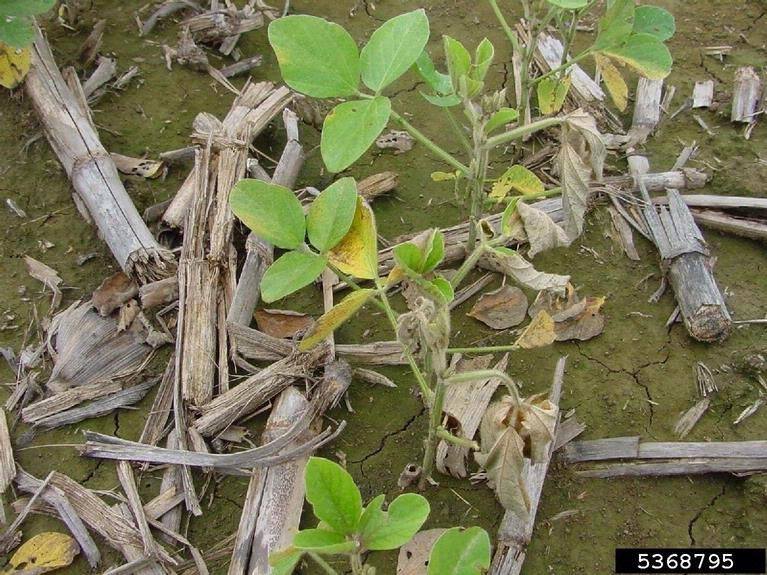
Symptoms:
- Stunted, spindly plants with light green color, which first appears on leaves lower in the canopy (older) leaves.
- Poor nodulation or inactive nodules on roots. Active nodules will appear pink inside when cut open.
Causes:
- Compacted soils, water-saturated soils, lower pH (<6.5) soils.
- Lack of nitrogen-fixing bacteria to colonize root nodules.
- Extremely low levels of available N in low organic-matter soils.
Treatment:
- For a pH problem, conduct a soil test and make lime applications before planting if the pH is too low (acidic).
- Use the correct seed-applied rhizobium inoculant before planting to correct a nitrogen deficiency potentially cause by low rhizobium populations.
- A nitrogen application during the growing season may be necessary when a soybean crop is grown on low organic matter soils (less fertile soils), when the soil is unable to supply the crop with enough N during the growing season, especially if there are concerns about proper nodule formation and function.

Symptoms:
- Stunted, spindly plants with small leaflets.
- Leaves usually have a dark green to bluish tint.
- Interveinal chlorosis starting from the base of the leaf.
- Slow overall growth.
Cause:
- The uptake of phosphorus is inhibited in acidic soils and in cool, wet soils.
- Low level of available phosphorus in the soil.
Treatment:
- Conduct a soil test and adjust pH to 6.5 to 7.0 with a lime application prior to planting.
- Apply a phosphate fertilizer before planting at a rate recommended by a soil test and incorporate the fertilize or place the fertilizer in the soil near the seed at a depth allowing for rapid root uptake.
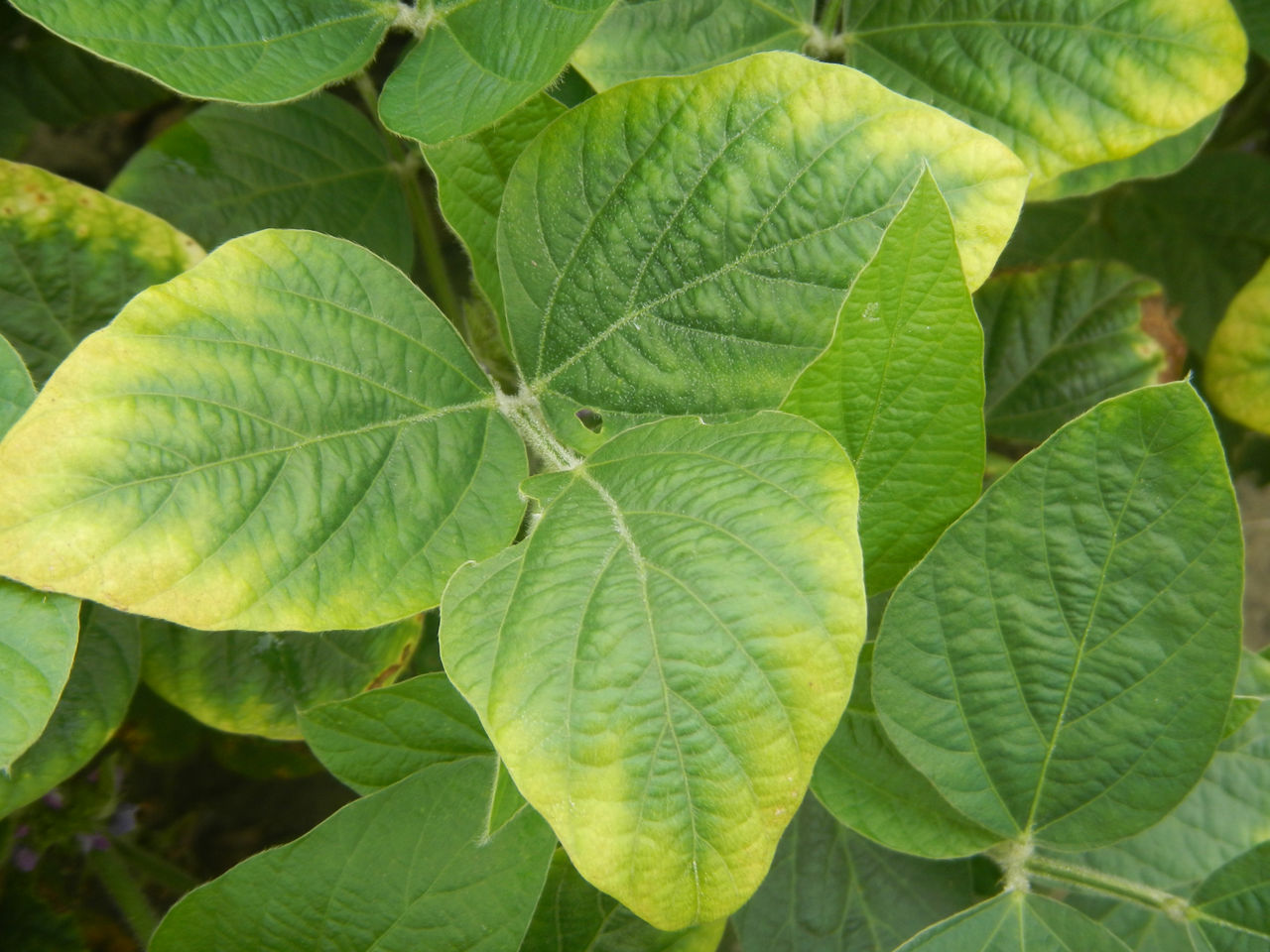
Symptoms:
- Yellowing, reddening, and necrotic (dying) leaf margins on lower (older) leaves during vegetative growth and on upper (younger) leaves during grain fill.
- The base of the leaf remains green.
- Ragged appearance of older leaves.
- Stunted and slow growth.
Causes:
- Low soil levels of potassium.
- Restricted root growth.
Treatment:
- Conduct a soil test and apply a potassium fertilizer before planting to adjust potassium levels based on test results. Soybean has a high potassium requirement.
- Relieve soil compaction so roots can grow properly in the soil.
Other Macronutrient Deficiencies
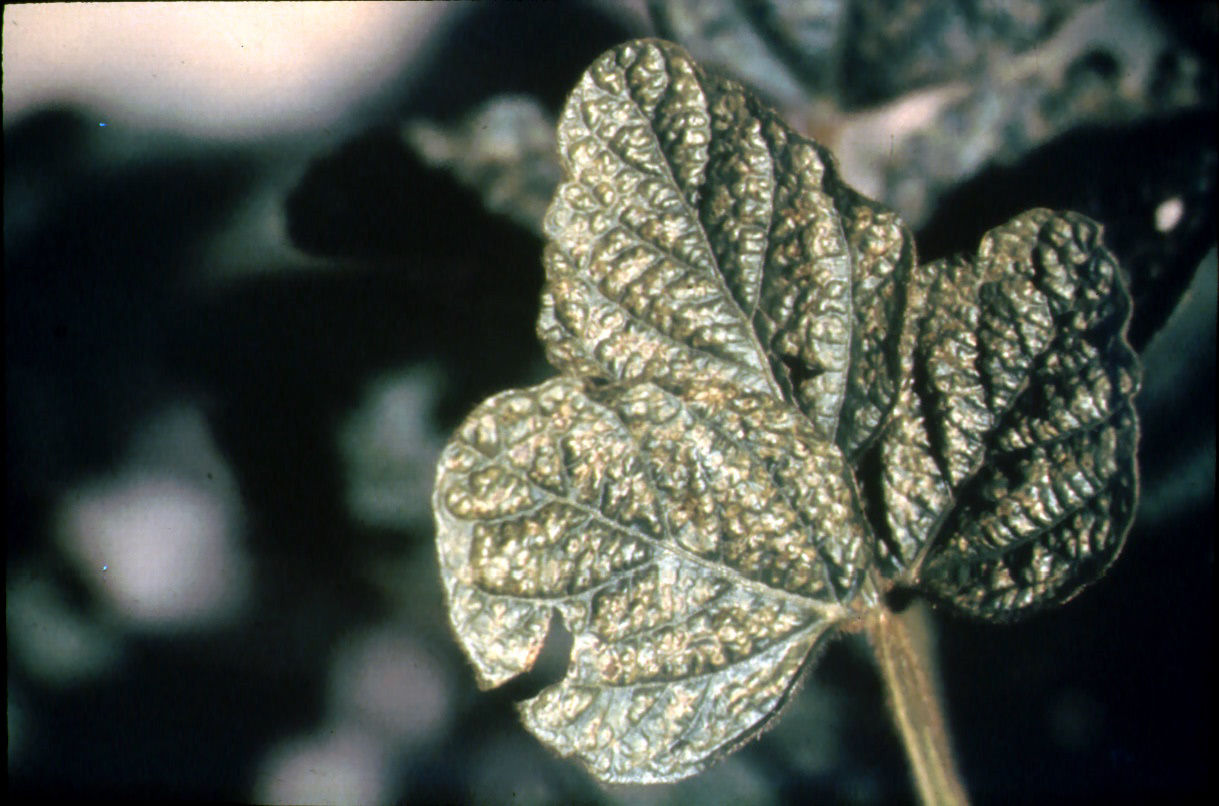
Symptoms:
- Necrosis of new growth leaf tips.
- Poor nodulation.
- Leaf symptoms appear like nitrogen deficiency.
- Deficiency rarely occurs in soybean.
Causes:
- Extremely low exchangeable calcium, usually associated with low pH (in mineral soils a pH<5.5, in organic soils a pH<4.8).
- Soils extremely high in potassium and magnesium.
Treatment:
- Conduct a soil test and adjust the pH to the optimum level for soybean growth (6.5 to 7.0).
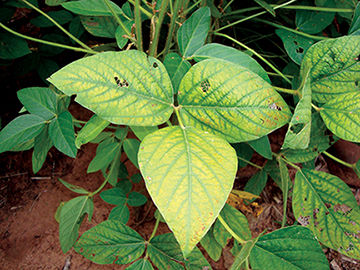
Symptoms:
- General symptoms look like a N deficiency with interveinal chlorosis.
- Leaf margins bend down.
- Older (lower) leaves are affected first.
- In later growth stages, the leaves may have a speckled bronze look.
- Early maturity showing up in older plants.
Cause:
- Magnesium deficiency is most prevalent in very deep, sandy, acidic soils.
Treatment:
- Conduct a soil test and apply dolomitic limestone if magnesium and pH levels are low.
- Make a foliar application of a magnesium product. Consult the product label for treatment rates.

Symptoms:
- New (upper) leaves are small and pale-yellow green.
- Stems are thin, hard, and elongated.
- Found on sandy soils low in organic matter.
- Wet, cool soils.
- Soils with reduced tillage or heavy residue.
Treatment:
- Conduct a soil test and apply sulfur fertilizer based on test results.
- Use a foliar application of sulfur. Consult the product label for treatment rates.
Micronutrient Deficiencies

Symptoms:
- Shortened internodes and yellowing or reddening of upper (newer) leaves.
- Poor flowering.
- Low yield.
- Poor seed quality.
Causes:
- Drought on sandy soils.
- Over liming of sandy soils with low organic matter.
Treatment:
- Conduct a soil test prior to planting and adjust boron by applying a boron fertilizer based on test results.
- During the growing season, use a foliar application of boron. Consult the product label for treatment rate. Do not exceed the recommended rate with a foliar application of boron, as plant injury can occur.
Symptoms:
- Lower seed yields.
- Interveinal chlorosis.
- Browning of leaf tips.
- Symptoms are rarely seen.
Causes:
- Found primarily on organic soils, especially those with high pH.
- Acidic, highly leached, sandy soils.
Treatment:
- Conduct a soil test prior to planting and apply a copper fertilizer to adjust levels based on test results.
- Use a foliar application of copper, preferably a chelated formulation. Consult the product label for recommended treatment rates.
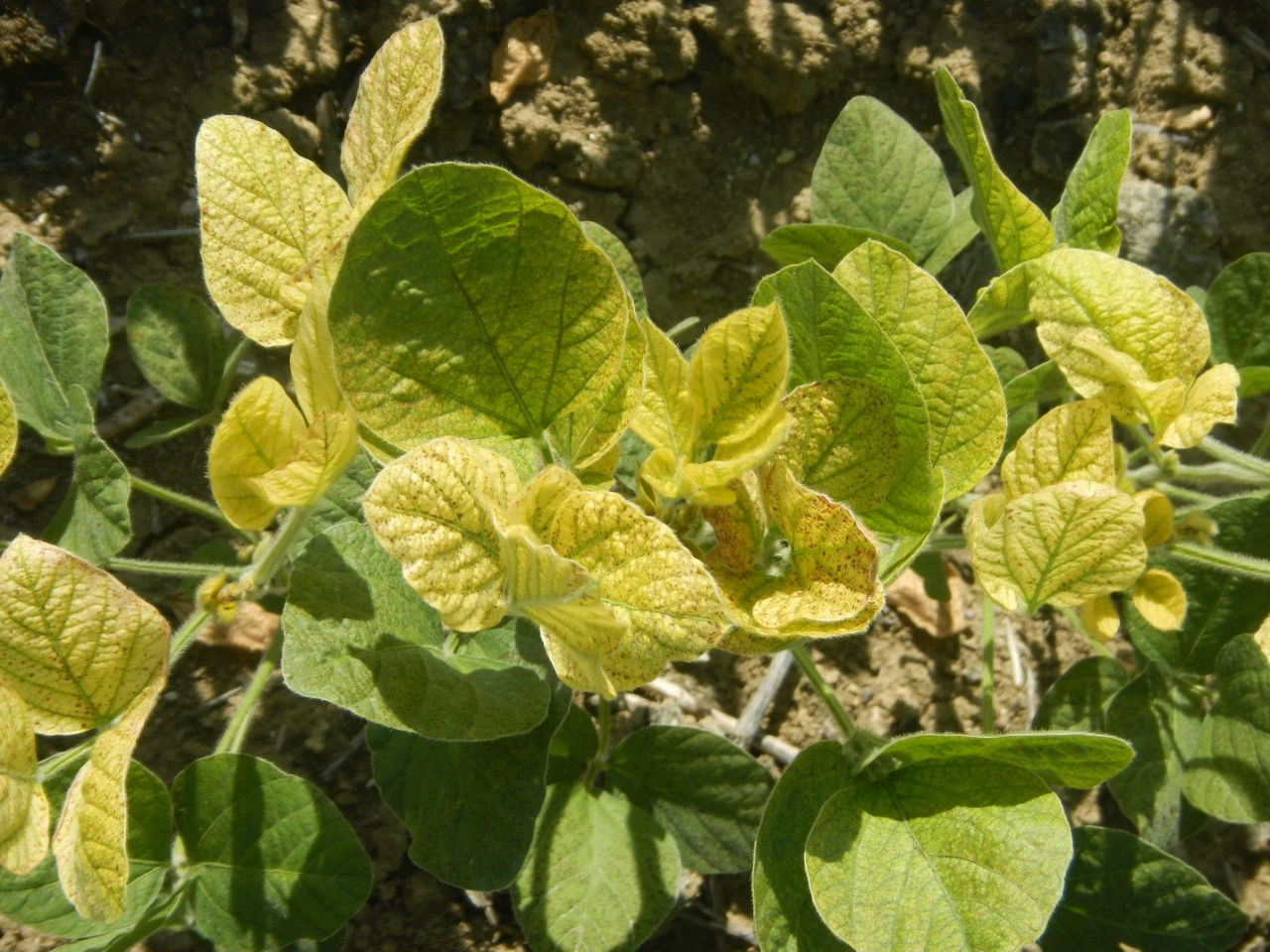
Symptoms:
- Stunting, interveinal chlorosis of younger (upper) leaves.
- Veins may also become chlorotic.
- Symptoms can vary year to year in the same field due to varying plant stresses.
Causes:
- High pH soils with free lime on the surface of the soil.
- Cold, wet, poorly aerated soils with elevated levels of manganese.
- Poor genetic tolerance – soybean products differ genetically in how tolerant they are to iron deficiency. Many seed suppliers provide an IDC (iron deficiency chlorosis) rating for their soybean products. This is a visual rating from one to five with five indicating the most severe chlorosis that indicates the severity of the iron deficiency.
Treatment:
- Conduct a soil test and avoid planting soybean on highly calcareous soils with a high soil pH.
- Use a soybean product with a good IDC rating.
- Use a foliar application of an iron chelate product. Consult the product label for treatment procedures and rates.
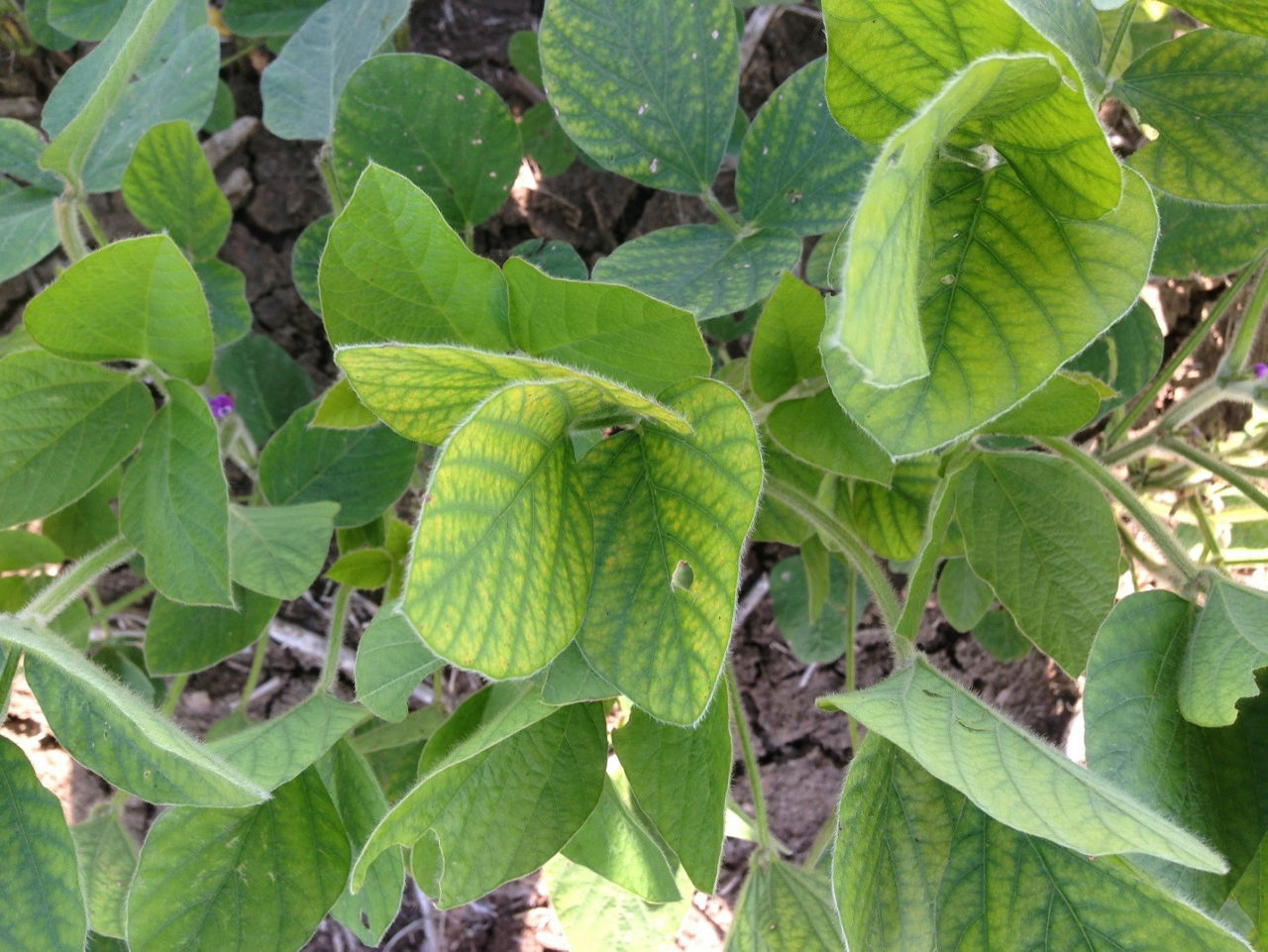
Symptoms:
- Interveinal chlorosis, though whole plants can appear pale green.
- Symptoms are similar to iron chlorosis.
- Stunting, brown necrotic (dead) spots, and early leaf drop.
- Early manganese deficiency resembles early iron deficiency.
Causes:
- Low soil levels of manganese combined with high soil pH (>7.0)
- Sandy soils with a high organic matter content (>6.0% OM).
- Depressed areas in fields.
- Organic peats and muck soils.
Treatment:
- Conduct a soil test and apply supplemental manganese based on test results.
- Use a foliar application of a manganese chelate product. Consult the product label for treatment rates.
Symptoms:
- Ineffective or few nodules on roots, resulting in nitrogen deficiency symptoms. Nitrogen-fixing rhizobia require a sufficient level of molybdenum to function correctly and produce adequate amounts of nitrogen.
- Chlorosis/necrosis of leaf tips and margins.
- Twisted leaves.
- Rolled leaf margins.
- Restricted growth and flower formation
Causes:
- Found on acidic, low organic matter prairie soils.
- Highly acidic, strongly weathered, leached soils.
Treatment:
- Apply a seed treatment or fertilizer containing molybdenum. Consult the product label for treatment rates.
- Conduct a soil test and apply lime pre-plant to a low pH soil to adjust the soil the optimum pH for soybeans growth (6.5 to 7.0).

Symptoms:
- Stunting of the stems in young plants with interveinal chlorosis on younger (upper) leaves.
- Leaves become bronzed or gray with necrotic tissue between veins, and leaves drop early (resembles sudden death syndrome).
- Few flowers form, abnormal pod development, and plants are slow to mature.
Causes:
- Low soil zinc levels combined with high soil pH or high soil phosphorus levels.
- Cool, wet soils low in organic matter.
- Cool, cloudy weather during early growth.
- Soil compaction that limits root growth.
Treatment:
- Conduct a soil test and make zinc fertilizer applications based on test results.
- Use a foliar application of a zinc chelate product. Consult the product label for treatment rates.
Other Causes of Plant Growth Abnormalities That Can Be Confused with Nutrient Deficiencies
Many common soybean diseases can resemble nutrient deficiencies. Sudden death syndrome (SDS) leaf symptoms can be often confused with a nutrient deficiency, because the interveinal chlorosis and necrosis that can show up after the R2 growth stage. Other soybean diseases that can be confused with nutrient deficiencies include brown stem rot (BSR), Phytophthora root and stem rot, Northern and Southern stem canker, bacterial pustule, and bacterial blight.
Many other conditions can mimic a nutrient deficiency by restricting root growth, such as plant-parasitic nematode damage. The common leaf symptoms caused by elevated levels of nematode feeding look like a nutrient deficient plant. Herbicide carryover problems, water-saturated soils, soil compaction, root damage due to insect root feeding, and drought can also obscure the condition that might be causing a soybean crop to look unhealthy. When trying to diagnose a plant growth concern, it can be helpful to use local extension soybean experts along with agronomists and seed dealers to help differentiate between nutrient deficiencies and other soybean production issues that might have similar symptoms.1,2,3
Sources
1Ruiz Diaz, D. 2023. Identifying nutrient deficiency symptoms in soybean. Kansas State University, Agronomy eUpdates. https://eupdate.agronomy.ksu.edu/article_new/identifying-nutrient-deficiency-symptoms-in-soybeans-551-5
22021. Purdue Corn and Soybean Field Guide. Purdue University Extension. https://ag.purdue.edu/department/agry/agry-extension/dtc/
3Nutrient Requirements – Soybean. Iowa State University Extension and Outreach, Integrated Crop Management Encyclopedia Article. https://crops.extension.iastate.edu/soybean/production_soilfert.html
Web sources verified 01/31/25. 1313_128004